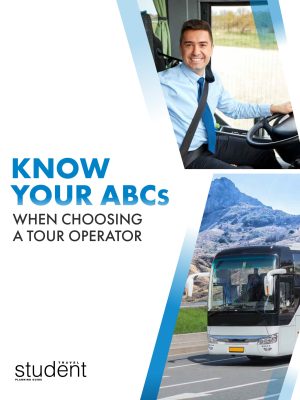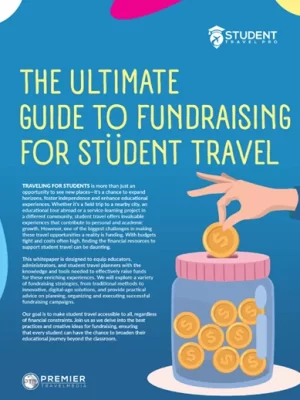As prospective college students gear up to make one of the most important decisions of their lives, campus tours offer the chance to explore, learn and connect
Preparing for college is a whirlwind, stressful endeavor for both students and parents. On top of the rigors of schoolwork, clubs and activities comes the long process of choosing the right school to attend and planning college campus tours.
This article is designed to demystify the often complex world of campus tours. It aims to fill the gap between the common knowledge about campus tours and the detailed information that is rarely provided. We offer the following practical advice and considerations to help you create a well-informed and effective college campus tour itinerary for your students.
For more student travel information and tips, be sure to Download the Full Student Travel Planning Guide and Subscribe for FREE
How to Choose College Campus Tours for Student Groups
In some ways, this step intersects with the larger question of which colleges students choose to apply to-but in important aspects, it is a different query entirely.

Ask your students these questions:
- Do you want a sprawling campus with a massive student body or something more tight-knit?
- Do you value high-caliber athletic programs or savor performing arts?
- Do city locations appeal to you more than suburban or rural locations?
- Most importantly, what subjects interest you? Are burgeoning engineering departments vital? A top-notch business school? Killer journalism courses?
Answering these questions at the onset will be paramount as students narrow down their list of schools. The reality is that 15 to 17-year-olds simply don’t know these answers. That’s where organized group college tours come into play. Instead of making mom or dad conduct ill-conceived windshield tours of college campuses, organized college tours, orchestrated by individual schools or entire districts cut through the clutter, presenting a variety of options for all students.
Different Types of College Tours
There are many types of college tours to consider, and each is unique.
First, the classic campus tour is what most think of when planning a college tour. This traditional option gives you the chance to walk around the grounds, often on a pre-determined route as part of a group guided by a current student or admissions officer. If you are in a smaller group, you can ask to see areas of the campus and departments you are especially interested in.
Second, there are college open houses, which colleges and universities use to recruit prospective students. This is a great way to get a good feel for the school while hearing from current students, alumni and representatives from the housing department, financial aid office and admissions department in theater-style presentations, followed by walking tours of campus.
Third, overnight visits are a relatively uncommon but informative option. Overnights allow touring students to shadow a current student across class and leisure time and spend a night in a residence hall. This immersive experience allows prospective students to understand what a day in the life of a student is really like.

When is the best time to take student groups on a college tour?
The spring semester of a student’s junior year is the most popular time for college tours, but there’s no need to wait that long! Getting freshmen and sophomores thinking about college will help them better envision their future and start setting academic club and athletic goals to help them get there.
Campus tours are held year-round, with spring being more popular than fall. Some high schools elect to host college tours over long weekends or spring break, as these “off times” seldom collide with traditional collegiate breaks.
It’s important to note that colleges are not in session around Thanksgiving, Christmas, and winter or spring breaks, so avoid these times. You will want to see the campus as your students would experience it—not an empty ghost town! Exam weeks might also be less representative of what the school’s vibe is truly like, so review each school’s academic calendar as you plan your trip.
How long should your college tour for students be?
When you’ve nailed down the time of year, your next consideration is how long you should plan your tour.
If you’re in a major metropolitan area, it’s possible to plan a full-day college campus tour and, with some good timing, see up to three campuses. And since you want your students to see multiple options, anything requiring more than a few hours drive should be considered an overnight.
While there are more logistical hurdles with overnight trips, this type of experience is a learning adventure for students – taking them out of their comfort zone and into a new environment.
Hotel stays, new experiences, group meals and bonding time with new friends all help your students visualize their future and stretch their social skills. When planning an overnight college tour, look for hotels in safe areas, within close proximity to campus and with included breakfast and competitive group rates.
Sample two-day college campus tour itinerary:
DAY 1:
9:00 a.m. – Depart school.
11:00 a.m. – Arrive at school tour #1, a large state university. Campus tour and lunch.
2:00 p.m. – Depart for school tour #2.
2:15 p.m. – Arrive at local liberal arts college. Presentation by the admissions department and campus tour.
4:30 p.m. – Depart for hotel.
5:30 p.m. – Arrive at your hotel.
6:30 p.m. – Dinner at a local pizza restaurant.
 DAY 2:
DAY 2:
8:00 a.m. – Breakfast at your hotel.
9:00 a.m. – Tour #3 Meet & Greet and campus tour of a technical university.
11:00 a.m. – Depart for tour #4 at a nursing school.
11:15 a.m. – Presentation and cafeteria lunch at nursing school followed by self-guided campus walking tour.
1:30 p.m. – Depart for tour #5.
2:00 p.m. – Arrive at private university and join the campus tour.
4:00 p.m. – Drive home.
7:00 p.m. – Arrive home.
Tips for Planning Your College Campus Tour Itinerary
- Campus visits should be planned trips, not spontaneous adventures. Setting aside time for careful planning will allow you to make sure you gain an understanding of the school while following the other recommendations set forth here.
- Encourage touring students to make their visits interactive: talk with current students, say hello to professors, and try to have conversations that enhance their feeling of what sets the school apart. Current students will probably tell the truth, so jump into conversations with them.
- Encourage students to take photos and videos. Especially if you’re seeing multiple schools, facilities can blend together, making the decision-making process more difficult. Have students take notes and save the pamphlets and recruitment papers provided by the schools. At worst, you might want these items as memorabilia from an exceptional trip, but more likely, they will provide helpful tools to students that can be valuable in reflection or if they need a reminder of anything they saw or did during the visit.
- While most organized campus tours take place over weekends, if you can orchestrate a weekday visit, you’ll see the campus in a different light, buzzing when classes are in session and professors are actively lecturing. Try to capitalize when your high school holidays occur on Mondays-these are often the best times around which to build your trip itinerary.
Places to Visit on Your College Campus Tour
This gets into the heart of your trip itinerary—where to go on campus.
First, before even touching academic buildings or sports complexes, a piece of advice that most campus planning guides omit is to visit the surrounding area. This trip should be focused on helping students get a feel for the whole area, not just the student center and library. Go to local restaurants and shops; walk around the football stadium; take a drive through the outlying neighborhoods; venture out to an off-campus grocery store. These experiences will give students a taste of what the community is like and what options they will have.

When you’re back on campus, your tour should focus on the places of interest to your group. For those who expect to do most of their studying in the library, that should be the first place to visit on campus. Likewise, athletes should check out sports facilities; runners should take a walk or run around the campus track. All prospective students should tour dorms and the dining halls, two of the places in which they will spend a lot of their time. Whenever possible, include visits to specific academic buildings of interest to your students—savvy college admissions directors can arrange meetings with faculty and students in these departments.
Campus tours require careful trip planning surrounding important decisions, from where your group will visit on campus to when you will tour and what sort of visit you prefer. Options are abundant, making a detailed itinerary even more vital. With this in mind, you can help guide students through interactive experiences that will aid them in making the most important decisions of their lives.
For more student travel information and tips, be sure to Download the Full Student Travel Planning Guide and Subscribe for FREE
By Jeff
Photos courtesy of Freepik.com










